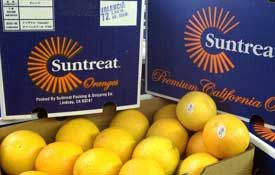
© suntreat
A cold snap in Chile is leaving summer citrus importers unsure of what they'll be bringing to the states in upcoming weeks.
David Mixon, chief marketing officer for Seald Sweet LLC, Vero Beach, Fla., said Chile's citrus-growing areas had an unseasonable cold snap over the July Fourth weekend. Until the industry can measure the damage done to its crop, which can take a week or even 10 days, the forecast of exports to the U.S. is clouded.
Mixon said the temperatures recorded there indicate an "extremely high" likelihood of damage to the citrus, but "it's hard to predict how the fruit will react, and there's a lot of variables."
Chile's cold snap is just the latest weather hurdle for the industry. South Africa, which exported a record 1.5 million metric tons of citrus last season, dealt with a yearlong draught and hailstorms that will limit the nation's citrus exports by 5% from last year's record.
Mixon said Chile typically kicks off the summer citrus program in late May with its clementines. Then South Africa starts exporting citrus around the middle of June. Both countries' seasons go through October. Peru - with fewer clementines and navels than those countries but more minneola tangelos - bolsters and diversifies the supply from the end of June through September.
Mixon said that while the industry expects less fruit out of South Africa, the fruit has had normal size and the quality has been "exceptional." He said the external color and internal flavor were both strong and brix counts were 1-3 points higher than usual.
He said the prices of international citrus have been about average, with no anticipation for any major shifts, but the jury is still out on what Chile's cold snap could mean to volumes and prices.
One fruit that probably won't escape the Chile cold snap untouched is lemons. Mixon said he was definitely expecting smaller-than-normal volumes of lemons, and therefore higher prices, but even the extent of those changes are yet unknown.
As international production has ramped up, the domestically grown summer citrus supply is winding down.
Al Imbimbo, vice president of sales and marketing for Suntreat Packing & Shipping Co., Lindsay, Calif., said his company was selling its last load of California navels.
"I think there will be some people who will be shipping California navels through August," he said, "but I have a feeling most will be shipped out sooner."
He said his company had the opportunity to string out its last load, to try to catch a possible uptick in price as supply dwindles, but didn't think the price would justify it. He said the quality of the fruit is good, and the sizes - of what they have left - were 72s, 56s, even some 88s.
Neil Galone, vice president of sales and marketing for Booth Ranches LLC, Orange Cove, Calif., said some major shippers will hold onto their navels as long as they can, but California is mostly done.
He said Booth starts its valencias in March or early April, before any domestic demand, to supply international interests. He said half of its valencia crop was harvested, and it has told its customers to expect them at least through August. He said the valencias have been mid-sized, peaking on 88s, with some 113s. He said the total estimate for California valencia production is 26 million boxes, which is close to average.
He said the average f.o.b.s for all grades and sizes are around $8.75, slightly stronger than last year. He said he expected the price to stay there.
or are we exporting our fruit so that we may import fruit from overseas?